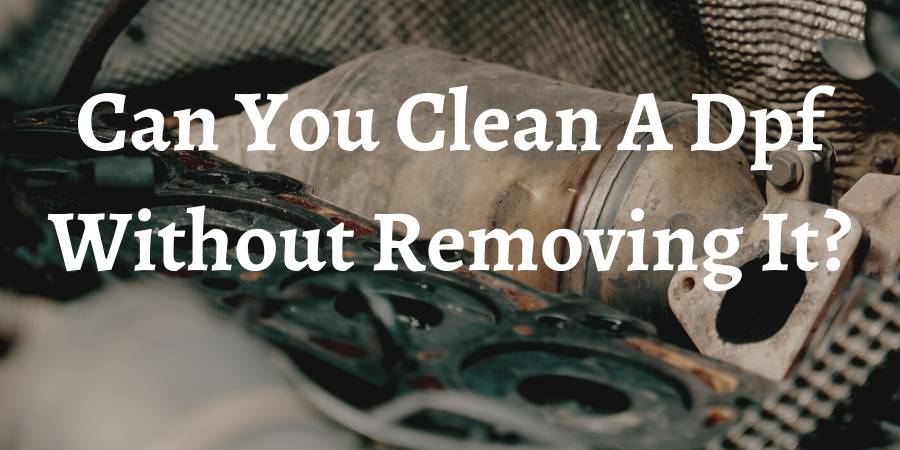
Introduction
Diesel engines have long been popular for commercial and heavy-duty vehicles and some passenger cars due to their fuel efficiency, torque, and durability.
However, they also produce significant harmful emissions, particularly particulate matter. In recent years, governments and regulatory bodies have enforced stricter emissions standards, leading to the widespread adoption of Diesel Particulate Filters (DPFs) in diesel vehicles.
This essay explores the question, “Can You Clean a Diesel Particulate Filter (DPF) Without Removing It?”
To answer this question, we will delve into the background of DPFs, discuss the importance of regular maintenance, and examine common cleaning methods.
Background on Diesel Particulate Filters (DPFs)
Diesel Particulate Filters (DPFs) are an essential component of modern diesel vehicles, designed to capture and store particulate matter (PM) from the exhaust gases.
The primary function of a DPF is to reduce the amount of harmful PM released into the atmosphere, helping diesel vehicles comply with increasingly stringent emissions standards.
DPFs typically consist of a ceramic or silicon carbide honeycomb structure, coated with a layer of precious metals such as platinum or palladium. As exhaust gases pass through the filter, the PM becomes trapped within the porous structure, while the cleaner exhaust gases continue to exit the tailpipe.
Importance of regular DPF maintenance
Regular DPF maintenance is critical to ensure optimal performance and longevity of the filter and prevent potential engine issues.
Over time, the trapped PM accumulates within the DPF, causing it to become clogged and less effective at filtering out harmful emissions. A clogged DPF can lead to reduced fuel efficiency, increased emissions, loss of engine power, and in severe cases, engine damage.
Thus, it is essential to regularly clean and maintain the DPF to avoid costly repairs and maintain optimal vehicle performance.
Common methods of cleaning DPFs
There are several methods commonly employed to clean and maintain DPFs. These include passive regeneration, active regeneration, forced regeneration, and aftermarket cleaning additives.
Each method has advantages and disadvantages, which will be discussed further in this essay.
Professional DPF cleaning services involve removing the filter from the vehicle and using specialized equipment to clean it thoroughly.
What Is A Dpf?
How Is a Dpf Filter Regenerated
Cleaning DPF Without Removal: Possible or Not?
Cleaning a Diesel Particulate Filter (DPF) without removing it from the vehicle depends on several factors, such as the type of DPF, the degree of clogging, and the engine’s overall condition.
This section will discuss these factors and the various cleaning methods available.
Factors affecting DPF cleaning
Degree of clogging
The soot and ash buildup level in the DPF can also affect the cleaning process. Mildly clogged filters may be easier to clean without removal, whereas heavily clogged filters might require professional cleaning or even replacement.
Engine Condition
The overall condition of the vehicle’s engine plays a significant role in the DPF cleaning process. A well-maintained engine is less likely to experience DPF filter problems and may require less frequent cleaning.
This is mainly due to the type of OIL that you use. Using the wrong oil can cause serious DPF Issues.
Passive Regeneration
How passive regeneration works
Passive regeneration is a natural cleaning process during normal driving conditions, particularly highway speeds.
The high exhaust temperatures cause the soot particles in the DPF to burn off, clearing the filter. Passive regeneration requires no intervention from the driver and is the least invasive method of DPF cleaning.
Active Regeneration
How active regeneration works
Active regeneration is initiated by the vehicle’s engine control unit (ECU) when it detects a certain level of soot buildup in the DPF.
During active regeneration, the ECU increases the exhaust temperature by injecting additional fuel and burning off the accumulated soot.
Sometimes, you can clear the DPF light by driving the car at highway speeds for an extended period to facilitate active regeneration.
Forced Regeneration
How forced regeneration works
Forced regeneration is a procedure a professional technician performs using specialized diagnostic equipment.
The technician connects the equipment to the vehicle’s OBD-II port and initiates the regeneration process, which increases exhaust temperatures to burn off the soot buildup.
Benefits and drawbacks
It requires a professional technician, and the cost will be higher than other methods. Try the simple methods first; if all else fails, you will likely need to go to a garage and have the job looked at professionally.
Aftermarket DPF cleaning additives
Effectiveness of DPF cleaning additives
Several aftermarket DPF cleaning additives claim to help clean the filter without removal by breaking down soot particles and aiding in their combustion.
Some drivers have reported success with these products, while others have found them ineffective or harmful. The effectiveness of these additives varies, and whether you can clean a DPF without removing it depends on the specific product and the degree of filter clogging.
Check out the reviews on any DPF additive you intend to use and look at what others have said about it. This is the best way of judging if it will work or not.
In summary, cleaning a Diesel Particulate Filter without removing it from the vehicle is possible under certain conditions.
Passive and active regeneration can effectively maintain and clean mildly clogged filters. Forced regeneration can address more severe clogging but may come with higher costs and the need for professional intervention.
Aftermarket additives offer a potential solution for some drivers but should be used cautiously due to the potential risks involved.
To ensure the best possible performance and longevity of your DPF, it is essential to maintain your vehicle’s engine, follow the manufacturer’s recommended maintenance schedule, and promptly address any DPF filter problems.
If you are considering purchasing a vehicle with a DPF, research the specific model and its reputation for reliability, as well as any potential issues related to the DPF system.
This can help you decide whether you should buy a car with a DPF filter and the associated maintenance requirements.
Ultimately, understanding the factors that influence DPF cleaning and the available cleaning methods will help you make the best decision for your vehicle and its specific needs.
Regular maintenance and prompt attention to any issues will ensure your DPF remains clean and functional, reducing the risk of engine damage and costly repairs.
Conclusion
The Diesel Particulate Filter is an important piece of equipment on your diesel car and needs to be looked after and maintained correctly. Failure to do so could be an expensive outcome and even the possibility that the cost of repairs outweighs the car’s value.
Reading references related to the above
Related Articles
- “A Comprehensive Guide to Diesel Particulate Filter (DPF) Regeneration“
- “Diesel Particulate Filters: How They Work, Common Problems, and How to Maintain Them“
- “The Impact of Driving Habits on Diesel Particulate Filter Life and Performance“
- “Evaluating the Effectiveness of DPF Cleaning Additives for Diesel Vehicles“
- “Understanding the Role of the Diesel Particulate Filter in Reducing Emissions and Maintaining Engine Performance“
